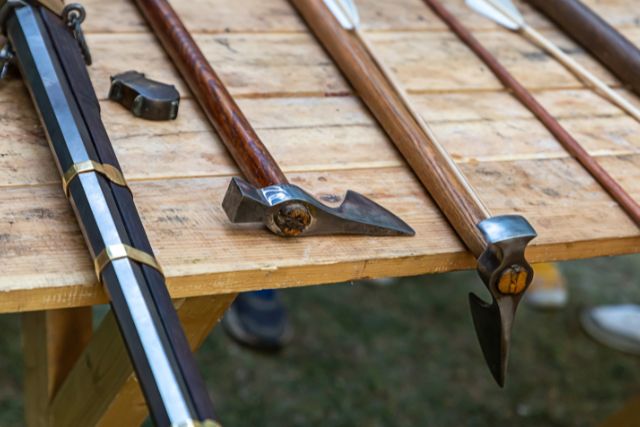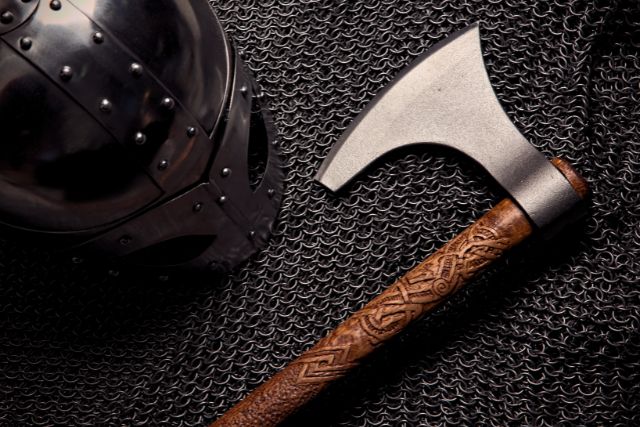From the fierce Norse warriors of old to the modern enthusiasts passionate about history, Viking axes have always been symbols of power, craftsmanship, and historical significance.
This guide aims to be the definitive resource for those seeking to purchase an authentic Viking axe, ensuring both the integrity of the artifact and the buyer’s satisfaction.
Introduction
The Viking Age, spanning from the late 8th to early 11th centuries, was a period of profound historical and cultural influence, with the Viking axe being one of its most emblematic artifacts.
Understanding the importance and history of Viking axes is crucial for any prospective buyer, as it gives context to their purchase and enriches the ownership experience.


Types of Viking Axes
Contrary to popular belief, not all Viking axes were created equal. From design to purpose, a variety of axes emerged throughout the Viking Age.
Bearded Axe
The Bearded Axe, characterized by its extended lower blade, was a versatile tool. Used both in battle and for daily tasks, its unique design allowed for a firm grip above the blade, making precise work easier.
Broad Axe
Primarily used for woodworking, the Broad Axe had a wide blade, perfect for shaping timber. Its specialized design was not ideal for combat but was invaluable for building and crafting.
Carving Axe
Smaller in design, the Carving Axe was tailored for intricate woodwork, especially for carving details into ship figureheads, totems, and other Viking artifacts.
Battle Axe
As the name suggests, this axe was made for war. Often heavier and more balanced, the Battle Axe was designed to deliver powerful strikes against enemy shields and armor.
Historical Significance and Usage
The Viking axe was more than just a tool or weapon; it was deeply intertwined with Norse culture and society.
Symbol of Power and Status
Ownership of a finely crafted axe was a sign of wealth and status. Often, the more intricate and ornate the design, the higher the owner’s standing in society. These axes were passed down through generations, becoming treasured family heirlooms.
Everyday Tool Versus Weapon
While the cinematic portrayal of Vikings often emphasizes their warring nature, many axes were primarily tools. They were used in daily tasks like wood-cutting, crafting, and building – reflecting the Vikings’ multifaceted society.
Cultural and Spiritual Significance
The axe had spiritual significance as well. It was frequently associated with Thor, the god of thunder, and was believed to have protective properties. Rituals and ceremonies often incorporated axes as symbols of divine power and blessing.
Identifying Authentic Viking Axes
As with any historical artifact, ensuring authenticity is crucial. A true Viking axe isn’t just old—it bears the marks of its era and origin.


Materials Used in Authentic Axes
Authentic Viking axes were crafted using specific materials and methods unique to their time.
Quality of Steel
The Norsemen were skilled metallurgists. An authentic axe would have been made using high-quality steel, often with a pattern-welded design, showcasing layers of iron and steel forged together.
Handle Materials and Construction
Axes from the Viking era typically had wooden handles, commonly made of ash or oak. The manner in which the handle is attached to the axe head, usually through a tapered hole, can also be indicative of its authenticity.
Historically Accurate Designs and Patterns
While many replicas mimic Viking designs, true Viking axes often have distinct patterns, wear marks, and designs that can be verified against historical records and artifacts.
Authenticity Marks and Manufacturer’s Stamps
Some axes might bear maker’s marks or other identifying stamps. However, be wary, as these can be forged. It’s always best to consult experts or detailed records when confirming authenticity based on markings.
Modern Reproductions Vs. Antique Axes
Modern reproductions can be compelling, especially for those who desire the Viking aesthetic without historical significance. But how do they stack up against antiques?


Benefits of Modern Reproductions
Modern reproductions often offer the Viking look with contemporary metallurgy and craftsmanship, resulting in a functional and durable tool that pays homage to its historical counterpart.
Pros and Cons of Antique Axes
Antique axes carry the weight of history, but they may not be suitable for active use. Their value often lies in their age, patina, and any accompanying stories or provenance.
Price Comparison
As expected, genuine antique Viking axes can command high prices, especially those in good condition or with a verified history. Reproductions, while less expensive, vary in price based on quality and craftsmanship.
Where to Buy Authentic Viking Axes
Finding an authentic Viking axe requires diligence, research, and often, a bit of luck.
Reputable Online Retailers
Several online platforms specialize in historical artifacts, but always check reviews, return policies, and any provided certificates of authenticity.
Antique Stores and Auctions
Physical locations, especially those specializing in historical artifacts, can be goldmines. Auctions, both physical and online, are also avenues to explore, though they might require deeper pockets.
Museums and Specialized Collections
While not always for sale, museums can be an excellent place to research and sometimes purchase replicas or even authentic pieces during deaccessioning events.
Checking the Credibility of Sellers
Always vet sellers, ask for provenance, and, if possible, consult third-party experts before making a purchase.


Caring for Your Viking Axe
Whether an antique or a high-quality reproduction, proper care ensures longevity and preserves the axe’s beauty.
Preserving the Blade
Proper blade care is essential, especially for antiques.
Sharpening and Maintenance
For those wishing to use their axes, regular sharpening is necessary. However, always use period-appropriate methods for antiques to avoid devaluation.
Storage and Handling
Store axes in dry places and handle them with clean hands. For antiques, consider display cases or wall mounts to minimize handling.
Caring for Wooden Handles
Periodic oiling keeps wooden handles from drying out and cracking. Linseed oil is a historical favorite, but other wood preservatives work as well.
Restoring Antique Axes
Restoration can be a double-edged sword. Improper restoration can devalue an artifact. Always consult experts before attempting any restoration work.
Conclusion
Owning a Viking axe, be it an antique or a well-crafted reproduction, is a journey into history, artistry, and craftsmanship. By making informed decisions, one can ensure that the axe remains a treasured possession for generations to come.
Additional Resources
For those hungry for more knowledge or looking to deepen their appreciation of Viking culture and artifacts, several resources are invaluable.


Books and Publications on Viking Axes
Countless academic publications and books dive deep into the intricacies of Viking weaponry. Libraries, bookstores, and online platforms are great places to start.
Documentaries and Historical Programs
Visual learners can benefit from well-researched documentaries detailing the Viking era, their tools, and their culture.
Workshops and Training Sessions
Hands-on experiences, such as blacksmithing workshops or Viking reenactment events, offer immersive opportunities to connect with the past.











